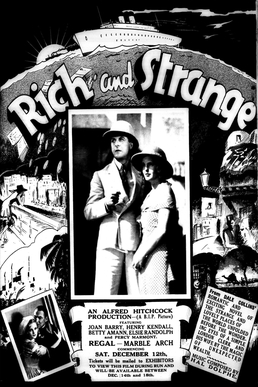
Young and Innocent, released in the US as The Girl Was Young, is a 1937 British crime thriller film directed by Alfred Hitchcock and starring Nova Pilbeam and Derrick De Marney. Based on the 1936 novel A Shilling for Candles by Josephine Tey, the film is about a young man on the run from a murder charge who enlists the help of a woman who must put herself at risk for his cause. An elaborately staged crane shot Hitchcock devised, which appears towards the end of the film, identifies the real murderer.
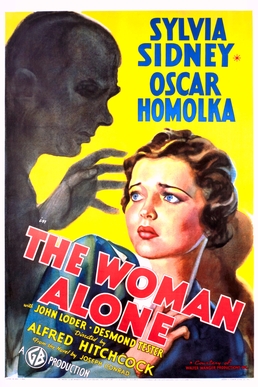
Sabotage, released in the United States as The Woman Alone, is a 1936 British espionage thriller film directed by Alfred Hitchcock starring Sylvia Sidney, Oskar Homolka, and John Loder. It is loosely based on Joseph Conrad's 1907 novel The Secret Agent, about a woman who discovers that her husband, the owner of a London movie theatre, is a terrorist agent.
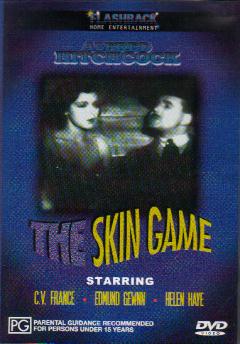
The Skin Game is a 1931 British drama film by Alfred Hitchcock, based on the 1920 play by John Galsworthy and produced by British International Pictures. The story revolves around two rival families, the Hillcrists and the Hornblowers, and the disastrous results of the feud between them.
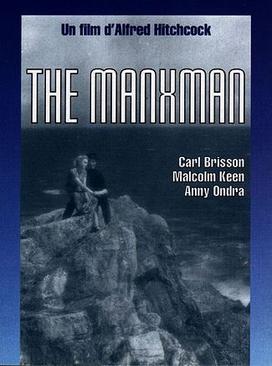
The Manxman is a 1929 British silent romance film directed by Alfred Hitchcock and starring Anny Ondra, Carl Brisson and Malcolm Keen. The film is based on a popular 1894 romantic novel The Manxman by Hall Caine, which had previously been made into a film 13 years earlier. It was the last fully silent production that Hitchcock directed before he made the transition to sound film with his next film Blackmail (1929).

Secret Agent is a 1936 British espionage thriller film directed by Alfred Hitchcock, adapted from the play by Campbell Dixon, which in turn is loosely based on two stories in the 1927 collection Ashenden: Or the British Agent by W. Somerset Maugham. The film stars Madeleine Carroll, Peter Lorre, John Gielgud, and Robert Young. It also features uncredited appearances by Michael Redgrave, future star of Hitchcock's The Lady Vanishes (1938), Michel Saint-Denis as the Coachman, and Michael Rennie in his film debut.

The Pleasure Garden is a 1926 British-German silent drama film directed by Alfred Hitchcock in his feature film directorial debut. Based on the 1923 novel of the same name by Oliver Sandys, the film is about two chorus girls at the Pleasure Garden Theatre in London and their troubled relationships.

The Farmer's Wife is a 1928 British silent romantic comedy film directed by Alfred Hitchcock and starring Jameson Thomas, Lillian Hall-Davis and Gordon Harker.
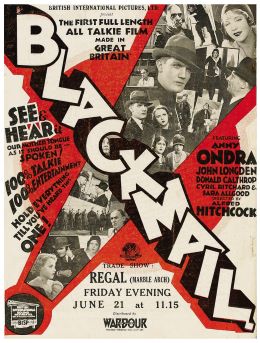
Blackmail is a 1929 British thriller directed by Alfred Hitchcock and starring Anny Ondra, John Longden, and Cyril Ritchard. Based on the 1928 play of the same name by Charles Bennett, the film is about a London woman who is blackmailed after killing a man who tries to rape her.

The Ring is a 1927 British silent romance film written and directed by Alfred Hitchcock and starring Carl Brisson, Lillian Hall-Davis and Ian Hunter.

Downhill is a 1927 British silent drama film directed by Alfred Hitchcock, starring Ivor Novello, Robin Irvine and Isabel Jeans, and based on the play Down Hill by Novello and Constance Collier. The film was produced by Gainsborough Pictures at their Islington studios. Downhill was Hitchcock's fourth film as director, but the fifth to be released. Its American alternative title was When Boys Leave Home.
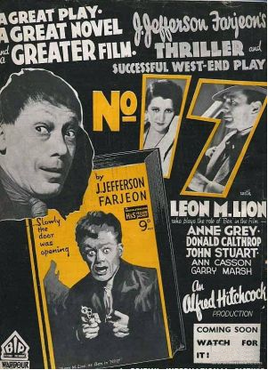
Number Seventeen is a 1932 British comedy thriller film directed by Alfred Hitchcock and starring John Stuart, Anne Grey and Leon M. Lion. The film, which is based on the 1925 burlesque stage play Number Seventeen written by Joseph Jefferson Farjeon, concerns a group of criminals who commit a jewel robbery and hide their loot in an old house over a railway leading to the English Channel. The film's title is derived from the house's street number.
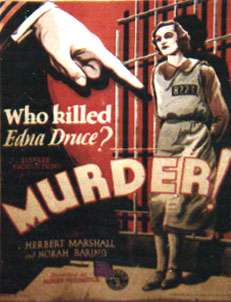
Murder! is a 1930 British thriller film co-written and directed by Alfred Hitchcock and starring Herbert Marshall, Norah Baring and Edward Chapman. Written by Hitchcock, his wife Alma Reville and Walter C. Mycroft, it is based on the 1928 novel Enter Sir John by Clemence Dane and Helen Simpson. It was Hitchcock's third all-talkie film, after Blackmail (1929) and Juno and the Paycock (1930).

Easy Virtue is a 1928 British silent romance film directed by Alfred Hitchcock and starring Isabel Jeans, Franklin Dyall and Ian Hunter.
Champagne is a 1928 British silent comedy film directed by Alfred Hitchcock and starring Betty Balfour, Gordon Harker and Jean Bradin. The screenplay was based on an original story by writer and critic Walter C. Mycroft. The plot concerns a young woman forced to take a job after her father loses his fortune.

The Man Who Knew Too Much is a 1934 British spy thriller film directed by Alfred Hitchcock, featuring Leslie Banks and Peter Lorre, and released by Gaumont British. It was one of the most successful and critically acclaimed films of Hitchcock's British period.

Mary (1931) is a British-German thriller film, directed by Alfred Hitchcock, and is the German-language version of Hitchcock's Murder! (1930), shot simultaneously on the same sets with German-speaking actors. The film is based on the 1928 book Enter Sir John by Clemence Dane and Helen Simpson, and stars Alfred Abel and Olga Tschechowa. Miles Mander reprises his role as Gordon Druce from Murder!, though the character's name was changed to Gordon Moore.

Jamaica Inn is a 1939 British adventure thriller film directed by Alfred Hitchcock and adapted from Daphne du Maurier's 1936 novel of the same name. It is the first of three of du Maurier's works that Hitchcock adapted. It stars Charles Laughton and Maureen O'Hara in her first major screen role. It is the last film Hitchcock made in the United Kingdom before he moved to the United States.

The 39 Steps is a 1935 British spy thriller film directed by Alfred Hitchcock, starring Robert Donat and Madeleine Carroll. It is loosely based on the 1915 novel The Thirty-Nine Steps by John Buchan. It concerns a Canadian civilian in London, Richard Hannay, who becomes caught up in preventing an organisation of spies called "The 39 Steps" from stealing British military secrets. Mistakenly accused of the murder of a counter-espionage agent, Hannay goes on the run to Scotland and becomes tangled up with an attractive woman, Pamela, while hoping to stop the spy ring and clear his name.

Elstree Calling is a 1930 British comedy musical film directed by Adrian Brunel and Alfred Hitchcock at Elstree Studios.

The Lady Vanishes is a 1938 British mystery thriller film directed by Alfred Hitchcock, starring Margaret Lockwood and Michael Redgrave. Written by Sidney Gilliat and Frank Launder, based on the 1936 novel The Wheel Spins by Ethel Lina White, the film is about an English tourist travelling by train in continental Europe who discovers that her elderly travelling companion seems to have disappeared from the train. After her fellow passengers deny ever having seen the elderly lady, the young woman is helped by a young musicologist, the two proceeding to search the train for clues to the old lady's disappearance.
